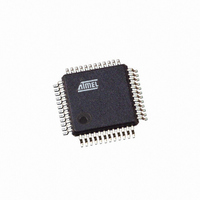ATMEGA406-1AAU Atmel, ATMEGA406-1AAU Datasheet - Page 56

ATMEGA406-1AAU
Manufacturer Part Number
ATMEGA406-1AAU
Description
IC AVR MCU 40K 1MHZ 48LQFP
Manufacturer
Atmel
Series
AVR® ATmegar
Specifications of ATMEGA406-1AAU
Core Processor
AVR
Core Size
8-Bit
Speed
1MHz
Connectivity
I²C
Peripherals
POR, WDT
Number Of I /o
18
Program Memory Size
40KB (20K x 16)
Program Memory Type
FLASH
Eeprom Size
512 x 8
Ram Size
2K x 8
Voltage - Supply (vcc/vdd)
4 V ~ 25 V
Data Converters
A/D 10x12b
Oscillator Type
Internal
Operating Temperature
-30°C ~ 85°C
Package / Case
48-LQFP
Processor Series
ATMEGA48x
Core
AVR8
Data Bus Width
8 bit
Data Ram Size
2 KB
Interface Type
2-Wire
Maximum Clock Frequency
1 MHz
Number Of Programmable I/os
18
Number Of Timers
2
Maximum Operating Temperature
+ 85 C
Mounting Style
SMD/SMT
3rd Party Development Tools
EWAVR, EWAVR-BL
Development Tools By Supplier
ATAVRDRAGON, ATSTK500, ATSTK600, ATAVRISP2, ATAVRONEKIT
Minimum Operating Temperature
- 30 C
Cpu Family
ATmega
Device Core
AVR
Device Core Size
8b
Frequency (max)
1MHz
Total Internal Ram Size
2KB
# I/os (max)
18
Number Of Timers - General Purpose
2
Operating Supply Voltage (typ)
5/9/12/15/18/24V
Operating Supply Voltage (max)
25V
Operating Supply Voltage (min)
4V
On-chip Adc
10-chx12-bit
Instruction Set Architecture
RISC
Operating Temp Range
-30C to 85C
Operating Temperature Classification
Commercial
Mounting
Surface Mount
Pin Count
48
Package Type
LQFP
Controller Family/series
AVR MEGA
No. Of I/o's
18
Eeprom Memory Size
512Byte
Ram Memory Size
2KB
Cpu Speed
1MHz
Rohs Compliant
Yes
For Use With
770-1007 - ISP 4PORT ATMEL AVR MCU SPI/JTAG770-1005 - ISP 4PORT FOR ATMEL AVR MCU JTAG770-1004 - ISP 4PORT FOR ATMEL AVR MCU SPI
Lead Free Status / RoHS Status
Lead free / RoHS Compliant
Available stocks
Company
Part Number
Manufacturer
Quantity
Price
Part Number:
ATMEGA406-1AAU
Manufacturer:
AT
Quantity:
20 000
12. External Interrupts
12.1
12.2
12.2.1
56
Overview
Register Description
ATmega406
EICRA – External Interrupt Control Register A
The External Interrupts are triggered by the INT3:0 pins. Observe that, if enabled, the interrupts
will trigger even if the INT3:0 pins are configured as outputs. This feature provides a way of gen-
erating a software interrupt. The External Interrupts can be triggered by a falling or rising edge or
a low level. This is set up as indicated in the specification for the External Interrupt Control Reg-
ister – EICRA. When the external interrupt is enabled and is configured as level triggered, the
interrupt will trigger as long as the pin is held low. Interrupts are detected asynchronously. This
implies that these interrupts can be used for waking the part also from sleep modes other than
Idle mode. The I/O clock is halted in all sleep modes except Idle mode.
Note that if a level triggered interrupt is used for wake-up from Power-down mode, the changed
level must be held for some time to wake up the MCU. This makes the MCU less sensitive to
noise. The changed level is sampled twice by the Slow RC Oscillator clock. The period of the
Slow RC Oscillator is 7.8 µs (nominal) at 25°C. The MCU will wake up if the input has the
required level during this sampling or if it is held until the end of the start-up time. The start-up
time is defined by the SUT fuses as described in
If the level is sampled twice by the Slow RC Oscillator clock but disappears before the end of the
start-up time, the MCU will still wake up, but no interrupt will be generated. The required level
must be held long enough for the MCU to complete the wake up to trigger the level interrupt.
• Bits 7:0 – ISC31, ISC30 - ISC01, ISC00: External Interrupt 3 - 0 Sense Control Bits
The External Interrupts 3 - 0 are activated by the external pins INT3:0 if the SREG I-flag and the
corresponding interrupt mask in the EIMSK is set. The level and edges on the external pins that
activate the interrupts are defined in
asynchronously. Pulses on INT3:0 pins wider than the minimum pulse width given in
on page 57
rupt. If low level interrupt is selected, the low level must be held until the completion of the
currently executing instruction to generate an interrupt. If enabled, a level triggered interrupt will
generate an interrupt request as long as the pin is held low. When changing the ISCn bit, an
interrupt can occur. Therefore, it is recommended to first disable INTn by clearing its Interrupt
Enable bit in the EIMSK Register. Then, the ISCn bit can be changed. Finally, the INTn interrupt
flag should be cleared by writing a logical one to its Interrupt Flag bit (INTFn) in the EIFR Regis-
ter before the interrupt is re-enabled.
Bit
(0x69)
Read/Write
Initial Value
will generate an interrupt. Shorter pulses are not guaranteed to generate an inter-
ISC31
R/W
7
0
ISC30
R/W
6
0
ISC21
R/W
5
0
Table 12-1 on page
ISC20
R/W
4
0
”System Clock and Clock Options” on page
ISC11
R/W
3
0
57. Edges on INT3:INT0 are registered
ISC10
R/W
2
0
ISC01
R/W
1
0
ISC00
R/W
0
0
2548E–AVR–07/06
Table 12-2
EICRA
25.





















